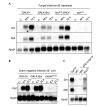Directed expression of the HIV-1 accessory protein Vpu in Drosophila fat-body cells inhibits Toll-dependent immune responses
- PMID: 12973300
- PMCID: PMC1326394
- DOI: 10.1038/sj.embor.embor936
Directed expression of the HIV-1 accessory protein Vpu in Drosophila fat-body cells inhibits Toll-dependent immune responses
Abstract
Human immunodeficiency virus 1 (HIV-1) expresses several accessory proteins that manipulate various host-cell processes to achieve optimum replicative efficiency. One of them, viral protein U (Vpu), has been shown to interfere with the cellular degradation machinery through interaction with SCF(beta-TrCP) complexes. To learn more about Vpu function in vivo, we used the genetically tractable fruit fly, Drosophila melanogaster. Our results show that the directed expression of Vpu, but not the non-phosphorylated form, Vpu2/6, in fat-body cells affects Drosophila antimicrobial responses. In flies, the Toll and Imd pathways regulate antimicrobial-peptide gene expression. We show that Vpu specifically affects Toll pathway activation by inhibiting Cactus degradation. Given the conservation of the Toll/nuclear factor-kappa B (NF-kappa B) signalling pathways between flies and mammals, our results suggest a function for Vpu in the inhibition of host NF-kappa B-mediated innate immune defences and provide a powerful genetic approach for studying Vpu inhibition of NF-kappa B signalling in vivo.
Figures





Similar articles
-
The HIV-1 Vpu protein induces apoptosis in Drosophila via activation of JNK signaling.PLoS One. 2012;7(3):e34310. doi: 10.1371/journal.pone.0034310. Epub 2012 Mar 29. PLoS One. 2012. PMID: 22479597 Free PMC article.
-
The human immunodeficiency virus type 1 Vpu protein inhibits NF-kappa B activation by interfering with beta TrCP-mediated degradation of Ikappa B.J Biol Chem. 2001 May 11;276(19):15920-8. doi: 10.1074/jbc.M010533200. Epub 2001 Feb 16. J Biol Chem. 2001. PMID: 11278695
-
HIV Vpu Interferes with NF-κB Activity but Not with Interferon Regulatory Factor 3.J Virol. 2015 Oct;89(19):9781-90. doi: 10.1128/JVI.01596-15. Epub 2015 Jul 15. J Virol. 2015. PMID: 26178989 Free PMC article.
-
Regulators of the Toll and Imd pathways in the Drosophila innate immune response.Trends Immunol. 2005 Apr;26(4):193-8. doi: 10.1016/j.it.2005.02.006. Trends Immunol. 2005. PMID: 15797509 Review.
-
Ubiquitin signalling in Drosophila innate immune responses.FEBS J. 2024 Oct;291(20):4397-4413. doi: 10.1111/febs.17028. Epub 2023 Dec 18. FEBS J. 2024. PMID: 38069549 Review.
Cited by
-
Convergent Evolution of HLA-C Downmodulation in HIV-1 and HIV-2.mBio. 2020 Jul 14;11(4):e00782-20. doi: 10.1128/mBio.00782-20. mBio. 2020. PMID: 32665270 Free PMC article.
-
Alternative Experimental Models for Studying Influenza Proteins, Host-Virus Interactions and Anti-Influenza Drugs.Pharmaceuticals (Basel). 2019 Sep 30;12(4):147. doi: 10.3390/ph12040147. Pharmaceuticals (Basel). 2019. PMID: 31575020 Free PMC article. Review.
-
A Naturally Occurring rev1-vpu Fusion Gene Does Not Confer a Fitness Advantage to HIV-1.PLoS One. 2015 Nov 10;10(11):e0142118. doi: 10.1371/journal.pone.0142118. eCollection 2015. PLoS One. 2015. PMID: 26554585 Free PMC article.
-
The HIV Tat protein affects processing of ribosomal RNA precursor.BMC Cell Biol. 2008 Jun 17;9:32. doi: 10.1186/1471-2121-9-32. BMC Cell Biol. 2008. PMID: 18559082 Free PMC article.
-
Potential Application of Drosophila melanogaster as a Model Organism in COVID-19-Related Research.Front Pharmacol. 2020 Sep 4;11:588561. doi: 10.3389/fphar.2020.588561. eCollection 2020. Front Pharmacol. 2020. PMID: 33013425 Free PMC article. No abstract available.
References
-
- Alexopoulou L., Holt A.C., Medzhitov R. & Flavell R.A. ( 2001) Recognition of double-stranded RNA and activation of NF-κB by Toll-like receptor 3. Nature, 413, 732–738. - PubMed
-
- Belvin M.P. & Anderson K.V. ( 1996) A conserved signaling pathway: the Drosophila toll–dorsal pathway. Annu. Rev. Cell Dev. Biol., 12, 393–416. - PubMed
-
- Bour S., Perrin C., Akari H. & Strebel K. ( 2001) The human immunodeficiency virus type 1 Vpu protein inhibits NF-κB activation by interfering with βTrCP-mediated degradation of IκB. J. Biol. Chem., 276, 15920–15928. - PubMed
-
- Doyle S. et al. . ( 2002) IRF3 mediates a TLR3/TLR4-specific antiviral gene program. Immunity, 17, 251–263. - PubMed
Publication types
MeSH terms
Substances
LinkOut - more resources
Full Text Sources
Molecular Biology Databases

